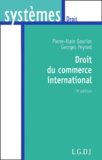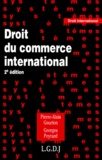International Trade Law

Philippe Deschamps(1)
Harvard Law School
Gourion, Pierre-Alain and Georges Peyrard. Droit du commerce international. Paris: Librairie Générale de Droit et de Jurisprudence, 2ème éd., 1997(2). Pp. 205. Index. Fr. 95.


Commercial lawyers and businessmen have every reason to feel pleased with the recent updating of the first edition of P.-A. Gourion and G. Peyrard’s Droit du commerce international. Using simple, direct language and illustrating their remarks with numerous examples drawn from the most recent events, Gourion and Peyrard provide a study which facilitates understanding of the fundamental legal principles governing international trade. The authors have clearly favoured a practical approach to a technical, disparate and diverse body of law, happily managing to summarize their arguments in some 200 pages.

The work is divided into three parts. The first section describes the structure of the principal world and regional organizations which regulate international trade. In this first section, the authors also list the various state sources (international conventions) and non-state sources (lex mercatoria) relating to international commercial activity. The second section sets out the categories of legal structures enabling companies to extend their activities abroad by way of export strategies, establishing overseas branches or by partnership, based on preliminary market analysis. A brief chapter is, moreover, devoted to a comparative legal study of the control of mergers and monopolistic practices. Finally, the third section, entitled ‘Legal Techniques of International Trade’, which alone takes up about half of the book, analyses in detail contracts of international sale, the control of international transport, the role of insurance, guarantees for the execution of contracts and the settlement of international trade disputes.

Highly structured, the text goes straight to the heart of the issues considered, but without falling into the trap of over-simplification or departing from its scientific rigour. The concepts used are carefully defined, compared and put in proper perspective. Thus, the authors’ analysis of the founding texts of relevant international organizations is peppered with case studies, which will enable readers to sharpen their critical faculties. In these case studies, the authors underline some of the commonly criticized gaps and other weaknesses affecting political stability and commercial relations between industrialized and developing countries.

In this revised edition, the authors have retained their notable argument in favour of the principles derived from the lex mercatoria, which they describe as an essential source of law for controlling international trade. Following the case of Pabalk Ticaret v. Norsolor (25 ILM [1985] 360), it has been established that French law, both judicial and arbitral, is in fact particularly favourable to such a process. Gourion and Peyrard support this, dedicating a substantial part of their work to analysing the use of mercantile law, praising its qualities of adaptability to the exigencies of modern economic reality. At the end of their study, the authors provide a very complete analysis of INCOTERMS and the diverse techniques of documentary credit, which practitioners will find useful.

It is regrettable that the section relating to the settlement of international conflicts in general, and in particular arbitration, has been awarded such a small share of the book. Judicial and arbitral case law occupies an important place at the core of international trade law. Undoubtedly, the enormity of the matter led the authors to refer the reader to specialist works.

The book discussed here can without hesitation be recommended to students, but also to those working with this area of law, be they lawyers or businessmen. Everyone concerned will find in this book a condensed and critical study of the principal legal concepts of international trade law.
Philippe Deschamps
Harvard Law School
(1) © 1990-2004 European Journal of International Law
All comments and suggestions should be sent to webmaster
This site is part of the Academy of European Law online, a joint partnership of the Jean Monnet Center at NYU School of Law and the Academy of European Law at the European University Institute.
(2) Une quatrième édition est à paraître aux Editions LGDJ. Voici, en avant-première, son avant-propos.
"Deux cents pages pour brosser un tableau du commerce mondial, éclairé aux ombres et lumières du droit, relève de la gageure : comment être précis et court,prospectif et descriptif, optimiste et réaliste ?
Depuis la première édition de cet ouvrage, en 1994, cette matière mouvante s’est renforcée comme structure d’organisation et de méthode. Elle a acquis son autonomie dans l’enseignement des Facultés de droit et a connu un développement éditorial remarquable. Cela parce qu’elle sert de médiateur en facilitant l’activité économique de l’homme.
Le droit du commerce international est au centre des tensions multiples de notre modernité. Dans l’œil du cyclone : entre l’humanisme souvent affiché et l’efficacité économique, à la rencontre du droit et de la réalité. Les tensions se trouvent aussi entre les conceptions même de ce qu’est le droit et, last but not least, entre les intérêts contradictoires des opérateurs.
Le sujet dépasse les conventions, les habitudes et les conforts universitaires. Mais une approche par la pratique seule évacuerait les indispensables repères d’une pensée structurée. Et notre monde en crise a besoin de se donner des règles communes, dans un aller-retour fécond entre le réel et la norme.
Cherchant son cap comme un voilier soumis à des vents contraires et capricieux, notre bateau-planète tente de se trouver une route structurante. C’est que l’on passe du droit de chaque Etat à celui d’une société internétisée où le virtuel, l’immatériel prend le pas sur la marchandise en s’y incorporant ; un monde marqué par la toute puissance contestée de l’empire américain, le tsunami de la fabrique chinoise et, hélas, la faiblesse politique de l’Europe ; un monde où l’émergence des ONG et d’une opinion publique internationale n’empêchent nullement les grandes entreprises multinationales, aidées par les Etats dont elles sont les plus proches, de développer leur impérialisme culturel, consumériste et financier.
Un monde étrange et violent fait de « bulles » qui explosent et d’hypocrisies soignées, avec les paradis fiscaux ou juridiques toujours remis en question mais toujours aussi présents. Un univers où règne une inflation de règles que chacun cherche à contourner allègrement. Ce livre est le fruit de la collaboration de trois juristes : un universitaire et deux praticiens, avec l’arrivée dans notre équipe de Nicolas Soubeyrand. C’est dire qu’il s’interdit de n’être qu’académique ou que concret. Il faut rêver et agir."
Pierre Alain GOURION
Septembre 2007


